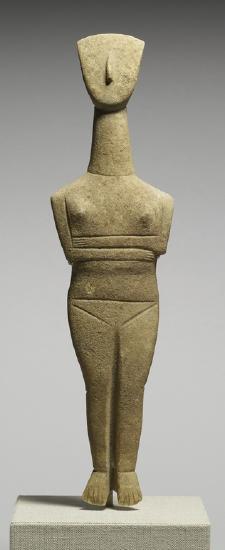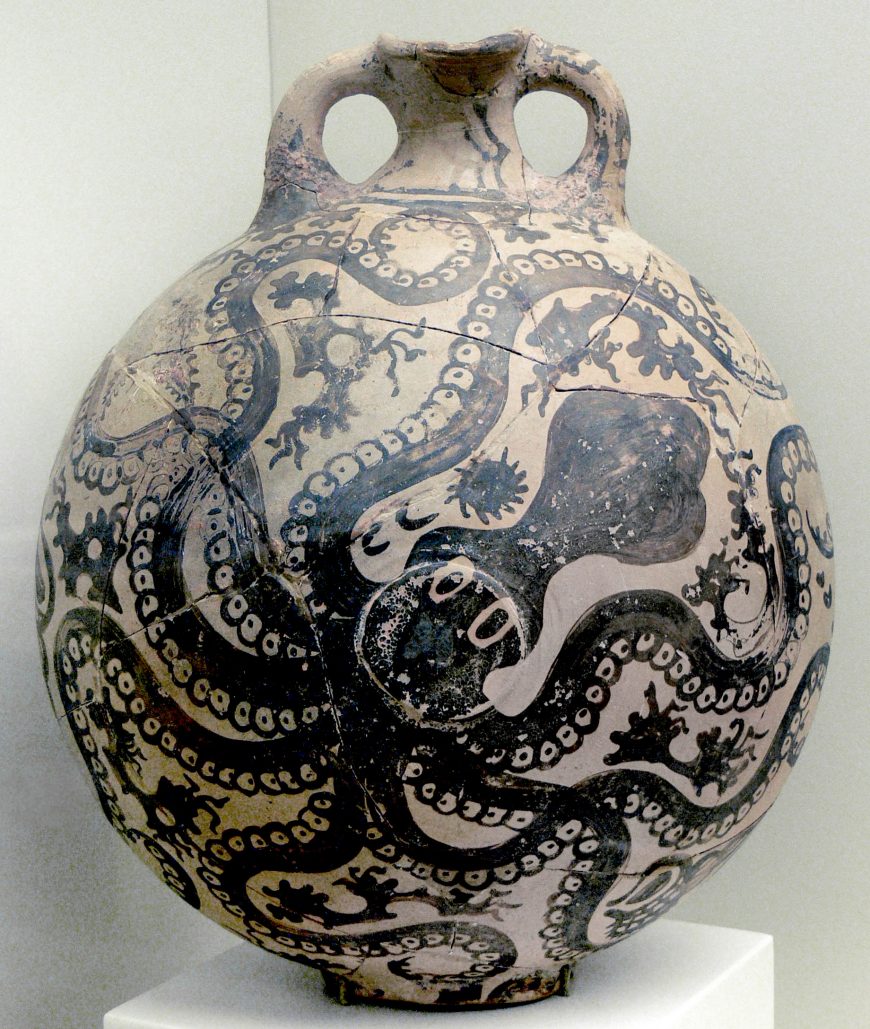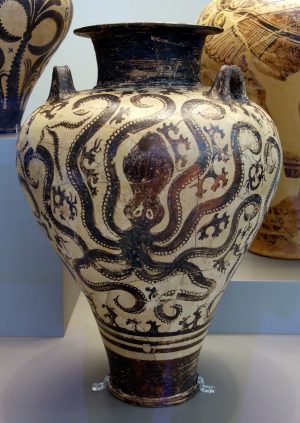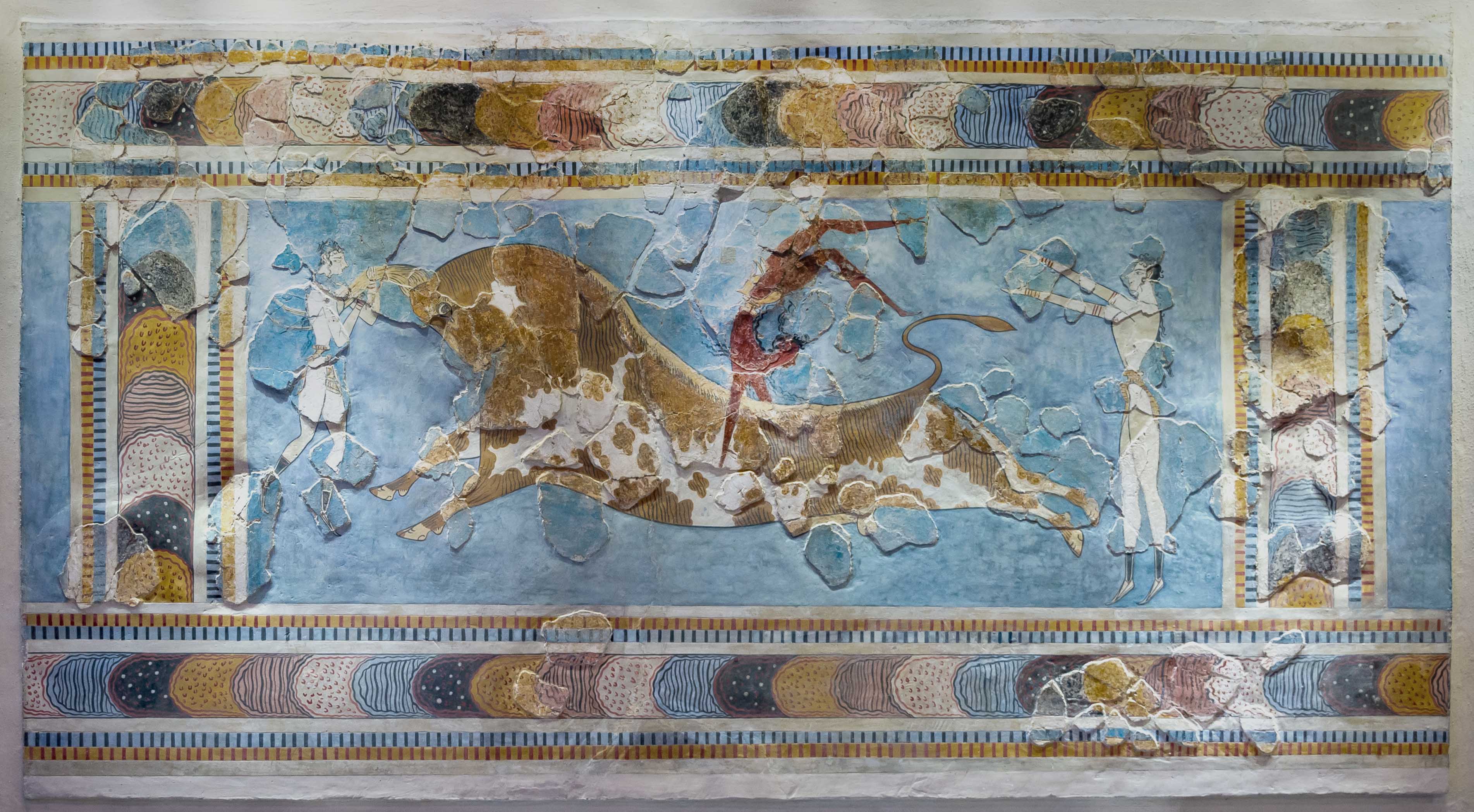Chapter 3: Ancient Aegean Cultures
Portions of the following text are taken from smarthistory.org, which is available for use under CC BY-NC-SA. Please see the citations at the bottom of the page for more information. The text has been adapted to more closely adhere to Chicago Manual of Style and Ensign College Style Guide.
The Aegean refers to the Aegean Sea, the northern portion of the Mediterranean between Greece and Turkey and extending south to the island of Crete. In art history, this designation refers to the era of the Bronze Age, the third and second millennium BCE. This era encompasses three different but interrelated cultures:
- The Cycladic islands
- The Minoans of Crete
- The Mycenaeans of the mainland of Greece
Relative to many ancient cultures, those of the Aegean were only recently discovered, at the end of the 19th century. The Classical Greeks and Romans never faded from memory, but the Mycenaeans and Minoans were largely forgotten, except in myth; it is the people and places of Bronze Age Crete and Greece featured in the Iliad and Odyssey of Homer.
The prehistoric Aegean was the first truly international age, and much of the art shows influence across cultures: Minoan wall painting owes much to Egyptian art; late Bronze Age Cypriot pottery imitates Mycenaean pieces. Today, the sites and art of the Minoans and Mycenaeans are some of the most popular of the ancient world.
Cycladic Art
The Cyclades are a group of Greek islands in the Aegean Sea that encircle the island of Delos. The islands were known for their white marble, mined during the Greek Bronze Age and throughout Classical history.

Their geographical location placed them, like the island of Crete, in the center of trade between Greece, Egypt, Asia Minor, and the Near East. The indigenous civilization on the Cyclades reached its high point during the Bronze Age. The islands were later occupied by the Minoans, Mycenaeans, and later the Greeks.
Cycladic Sculptures
Cycladic art is best known for its small-scale, marble figurines. From the late fourth millennium BCE to the early second millennium BCE, Cycladic sculptures went through a series of stylistic shifts, with their bodily forms varying from geometric to organic. The purpose of these figurines is unknown, although all that have been discovered were located in graves. While it is clear that they were regularly used in funerary practices, their precise function remains a mystery.
Some are found in graves completely intact, others are found broken into pieces, and others show signs of being used during the lifetime of the deceased, but some graves do not contain the figurines. Furthermore, the figurines were buried equally between men and women. The male and female forms do not seem to be identified with a specific gender during burial. These figures are based on simple geometric shapes.
Modern-Day Reception and Questionable Provenance
The clean lines and modern-seeming abstraction of these Cycladic sculptures, especially the folded-arm figurines, or FAFs, made them very attractive to collectors—and unfortunately resulted in some unethical and truly destructive behavior, from robbing graves to creating fakes. For this reason, especially with these FAFs, it’s very important to know the object’s provenance: where it came from, who found it, and what collections it has belonged to since then.
Cycladic Female Figures

Cycladic Male Figures

Tier 1: Content—Cycladic Figures
Like all artwork, the content of this work contains elements worth exploring. As you consider this work, refer to the elements of art listed in Tier 1: Content.
In these small figurines, artists paid careful attention to line, form, and composition. The abstract female figures all follow the same mold. Each is a carved statuette of a nude woman with her arms crossed over her abdomen. The bodies are roughly triangular and the feet are kept together. The head of the woman is an inverted triangle with a rounded chin, and the nose of the figurine protrudes from the center. Each figure has modeled breasts, and incised lines draw attention to the pubic region with a triangle. The swollen bellies on some figurines might indicate pregnancy or symbolic fertility. The incised lines also provide small details, such as toes on the feet, and delineate the arms from each other and the stomach. Their flat back and inability to stand on their carved feet suggest that these figures were meant to lie down. While today they are featureless and remain the stark white of the marble, traces of paint allow us to know that they were once colored. Paint would have been applied on the face to demarcate the eyes, mouth, and hair. Dots were used to decorate the figures with bracelets and necklaces.
Male figures are also found in Cycladic grave sites. These figures differ from the females, as the male typically sits on a chair and plays a musical instrument, such as pipes or a harp. Harp players, like the one above, play the frame harp, a Near Eastern ancestor of the modern harp. The figures, their chairs, and the instruments are all carved into elegant, cylindrical shapes. Like the female figures, the shape of the male figure is reliant on geometric shapes and flat planes. The incised lines provide details (such as toes), and paint previously added distinctive features to the now-blank faces. While reclining female and seated male figurines are the most common Cycladic sculptures discovered, other forms were produced, such as animals and abstracted humanoid forms. Examples include the terracotta figurines of bovine animals (possibly oxen or bulls) that date to 2200–2000 BCE, and small, flat sculptures that resemble female figures shaped like violins; these date to the Grotta-Pelos culture, also known as early Cycladic I (ca. 3300–2700 BCE). Like other Cycladic sculptures discovered to date, the purposes of these figurines remain unknown.
Let's look at one of these figures in greater detail.

We're in the National Archaeological Museum in Athens, and we're looking at a small sculpture of a man seated on a chair, playing a harp. But what makes this a remarkable object is that it's probably about 5,000 years old.
There are only about 10 of these that have been discovered in the Cycladic Islands in the South Aegean.
Mostly what we've found are tall, thin, highly abstracted female figures, and these have mostly been found in graves.
They were produced over hundreds and hundreds of years, of various sizes.
We don't know a lot about these sculptures, and the reason for that is that perhaps only 10 percent of these figures have been recovered by modern archaeologists in controlled conditions. The vast majority of these sculptures, male and female, have come to light on the art market. That is, somebody has gone in and unearthed them in order to sell them. The result is we have no scientific archaeological records of where they were found, at what level they were found, so the chronology, etc., is almost impossible.
Right. We don't know what they were found with. We don't know anything about the context of the find, and in fact, we'll never know, because that knowledge is just permanently lost. So not only do we have a problem with the archaeological record, but we also have a problem because these were so popular in the early 20th century. They were discovered by modern artists, and therefore we think many of them may have been created as forgeries.
So the art market, we think, is awash with authentic objects that have been unearthed illegally, as well as forgeries, that is, objects that have been produced in the modern world, in order to look as if they were ancient. When we look at these objects, we can see why the modern artists fell in love with these. There's a kind of simplicity. We know that Brancusi responded to these. We know that Modigliani responded to these. We know that Picasso loved these objects.
They're highly abstract, and they look that way to us in a way that is not really true to what they originally looked like. We know that areas of the sculptures were painted with very bright colors, and so this pristine white marble abstract form, that we so appreciate in the modern era, is not what the people of Crete were producing.
And look at the differences between the male and female figures. The male figures are rounded. The furniture is rounded. It's tubular. The figure's head is back as if perhaps he's singing, but of course, we don't know. There is a little projection from that harp, which we think may be the head of a bird, perhaps a swan. Again, we really don't know. Whereas, the female figures are more frontal, more planar, and they are incised in a way that accentuates the geometry of their bodies.
Not only are the female figures abstract, but they're also very compact. The limbs are folded in. There's no space between the arms and the torso. There's no space between the legs. The knees are just slightly bent. There's no real sense of movement.
It is a closed composition that emphasizes the overall contour of the figures. Look at the shield-like shape of the face and the way that the nose projects. They're beautiful without eyes, but there were painted eyes. There was a painted mouth. We initially see these as flat, but when we spend a moment looking at them, we see that the head is at one angle, the neck at another. Then we have the more complicated surface of the torso. Then it seems as if the thighs project outward and the shins inward again, and then, of course, we have the reverse with the feet, and so there is this almost slight accordion-like folding of the body.
With later Greek sculptures, we might think about Kouroi figures from the seventh century, much later and on the Greek mainland. There we see male figures nude and female figures clothed. And here, these female figures are all nude. That has led some art historians and archaeologists to speculate that maybe these are somehow related to neolithic fertility goddesses.
But the key word here is speculate, because we have no written records. All we have is the object itself. They have been stripped of all of their original cultural meaning, and in some ways that is also a very modernist idea, that we can appreciate the aesthetics, the object itself, unencumbered by what their real meaning was.
Minoan Art
One of the most important aspects of Minoan culture was its ceramics. Pottery today may not seem particularly interesting or important, but in the second millennium BCE, it was a high art form, and its manufacture was often closely associated with centers of power. Much like the production of porcelain for European royal houses in the 18th century, the production of pottery on Crete tells us about elite tastes, how the powerful met and shared meals, and with whom they traded.
The Octopus Vase
This vase, found at Palaikastro, a wealthy site on the far eastern coast of Crete, is the perfect example of elite Minoan ceramic manufacture. It is 27 cm (about 10.5 inches) high, wheel-made, hand-painted, and meant to hold a valuable liquid—perhaps oil of some kind. Its shape is somewhat unusual, constructed by slipping together, while still leather hard (clay that is not quite dry), two shallow plates which had been made on a fast spinning potter’s wheel with highly refined clay. The circular bases of these shallow plates are still visible in the center of both sides of the flask. A spout and stirrup-style handles (which would allow the user to carefully control the flow of the liquid out of the container) were added by hand, as well as a base, to facilitate the standing upright of the vessel.

Lastly, the Marine Style decoration would have been added. Using dark slip on the surface of the clay, the Minoan painter of this vessel filled the center with a charming octopus, swimming diagonally, with tentacles extended out to the full perimeter of the flask and wide eyes that stare out at the viewer with an almost cartoon-like friendliness. Around this creature’s limbs, we find sea urchins, coral, and triton shells; no empty space is left unfilled, lending a sense of writhing energy to the overall composition.
 .
.Marine Style pottery, of which this vessel is a prime example, is regarded as the pinnacle of Minoan palatial pottery production, specifically of the LM I period (around 1400 BCE). Those who believe “hands” (that is, specific artists) can be identified in the painting of Bronze Age pottery have identified this vessel as the work of the Marine Style Master, who worked at the site of Palaikastro. The era of Marine Style pottery coincided with a period during which the Minoans’ trade networks spanned widely across the Mediterranean, from Crete to Cyprus, the Levant, mainland Greece, and Egypt. Some have connected this seafaring skill to the popularity of Marine Style pottery. The style was imitated by potters on the Greek mainland as well as the islands of Melos and Aegina, but none could match the charm and grace of the Minoan inventors of the style.
Questions to Consider
- How were vases likely used at the time of its production?
- What does the decoration on this vase tell us about the artist and the culture that produced it?
Apart from ceramics, a limited number of other works survive from this puzzling civilization. One of these is the famous Bull-leaping Fresco from the palace of Knossos. Since only fragments of the original survive, modern art historians have pieced them together to reconstruct the likely original image and style. The resulting image invites speculation about what role this image held during this period and what sort of activity this image depicts.
